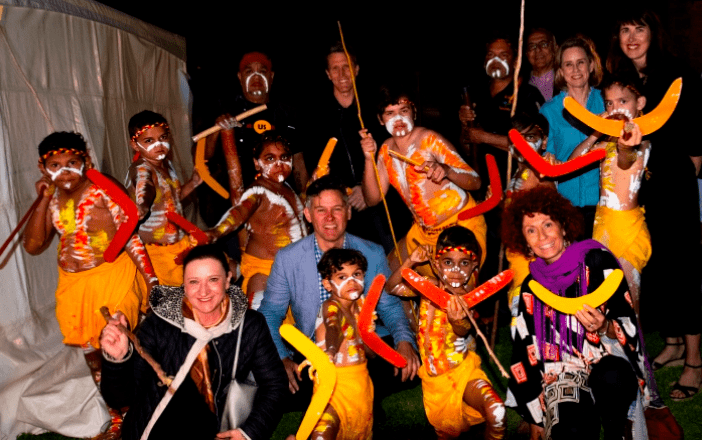Mega wombat haul unearthed in the Pilbara
 I haven’t looked a diprotodon in the eye since 2002.
I haven’t looked a diprotodon in the eye since 2002.
In real life, this wombat-related herbivore grew up to 3.8m long, weighed nearly three tonnes and stood up to 2m high. I’d love to ride one, shaak style.
Unfortunately, the evolutionary wheels fell off this unusual mammal after climate change and hunting wiped out the prehistoric marsupial and most of the Australian megafauna (animals weighing more than 46kg).
One of the most well known and widespread in Australia, Diprotodon optatum co-existed with indigenous people for thousands of years before it went extinct about 40,000 years ago.
The remains of Diprotodon, which means ‘two forward teeth’, were first discovered in 1830 in NSW and described in 1838 by English anatomist Richard Owen.
The earliest forms were the size of a sheep. The only marsupial living or extinct known to migrate also is related to mythological figures such as the ‘bunyip’ that lurks in swamps and billabongs (see latest issue of Freo StreetWise).
 In 1991, WA Museum palaeontologists unearthed a complete skeleton of the megamarsupial dated to at least 80,000 years old at Du Boulay Creek near the mouth of the Fortescue River.
In 1991, WA Museum palaeontologists unearthed a complete skeleton of the megamarsupial dated to at least 80,000 years old at Du Boulay Creek near the mouth of the Fortescue River.
 The skeleton is on display in Perth (opposite), the skeleton first noticed by a worker from the WA Agriculture Protection Board who was monitoring a noxious weed infestation.
The skeleton is on display in Perth (opposite), the skeleton first noticed by a worker from the WA Agriculture Protection Board who was monitoring a noxious weed infestation.
Further finds emerged in 1992 and 1996.
In recent weeks, palaeontologists have returned to the Pilbara site near CITIC Pacific Mining’s Sino Iron mining operations between Karratha and Onslow and recovered several nearly complete skeletons of diprotodon adults and juveniles, suggesting they died while following a major migration route.
 Sections of skulls, jaws and teeth were embedded in hard rock at risk of heavy abrasion by flooding, so it was critical the remains be excavated and preserved as part of a partnership between the Museum, Foundation for the WA Museum and CPM in consultation with local elders.
Sections of skulls, jaws and teeth were embedded in hard rock at risk of heavy abrasion by flooding, so it was critical the remains be excavated and preserved as part of a partnership between the Museum, Foundation for the WA Museum and CPM in consultation with local elders.
Team leader and WA Museum curator of mammalogy Kenny Travouillon told StreetWise the fossils needed to be removed because of severe erosion in the creek.
“New fossils are exposed but it’s destroying the ones that have been exposed for a long time,” he said from the site today.
 The WA Museum team has exposed the remains of 11 individual diprotodons, having returned to check the site for the first time in 30 years in October last year: “We found the first bone, then 10 individual skeletons by the end of the trip.”
The WA Museum team has exposed the remains of 11 individual diprotodons, having returned to check the site for the first time in 30 years in October last year: “We found the first bone, then 10 individual skeletons by the end of the trip.”
So far, five of the diprotodon skeletons have been recorded and preserved.
Asked whether the team identified other megafauna-related fossils, Dr Travouillon said: “We found snails, oysters and fossilised mangrove roots which tell us this was once a mangrove environment.”
Remarkably, this second trip also has identified a second mammal – a giant wombat estimated to have weighed 200kg, modern wombats weighing between 30kg to 50kg. Believed to be Phascolnus gigas, the giant wombat is the biggest burrowing marsupial ever known to have existed.
“It evolved at the same time as the modern wombat, but went extinct as a result of climate change and impact of humans. We have only one jaw so far. We expect there will other species, we just haven’t found them yet.”
Megafauna menagerie
 ‘Historic Find’, ‘Biggest fossil find of a century’ and ‘Beneath the desert, the past blooms’.
‘Historic Find’, ‘Biggest fossil find of a century’ and ‘Beneath the desert, the past blooms’.
That is how Australian and international media described the stunning discovery in 2002 of a treasure trove of megafauna fossils concealed for tens of thousands of years beneath the Nullarbor Plain. This author was privileged as science writer at The West Australian and only Australian journalist invited on the expedition to witness the underground dig first hand.
Marsupial lions, giant short-faced kangaroos, horned wallabies with sickle-like claws and a wombat the size of a small car were carefully brought to the surface after excavations in three caves into which the extinct species fell – Last Tree Cave, Flightstar and Leaena’s Breath.
I was there for several days with West photographer John Mokrzycki.
To reach the remains, WA Museum palaeontologists and speleologists had to abseil into the caves with hard hats and torch light, climbing and crawling up to 50m beneath the crust. The site is dated at between 1.75 million and 46,000 years old.
 The highlight of the expedition was discovering the first complete and nine nearly complete skeletons of Australia’s fiercest predator, the extinct marsupial lion Thylacoleo carnifex, nicknamed ‘Leo’ (opposite).
The highlight of the expedition was discovering the first complete and nine nearly complete skeletons of Australia’s fiercest predator, the extinct marsupial lion Thylacoleo carnifex, nicknamed ‘Leo’ (opposite).
Weighing more than 100kg, the genus was first published in 1859 by Owen. T. carnifex had the strongest bite of any mammal, living or extinct, with a bite comparable to that of a 250kg African lion.
Rock art depicting what is thought to be Leo was discovered in the Kimberley in 2008. A second image found in 2009 depicts an animal attacking a hunter in the act of fending it off with a multiple-barbed spear.
Palaeontologist John Long, now at Flinders University, and myself spent hours sitting on the cave floor drip-feeding binding liquid on to the fragile bones including every single vertebrae in Leo’s tail.
 The bones hardened before they were removed from their prehistoric tomb near the WA-South Australian border as part of Operation Leo (Featured in Freo StreetWise Issue 14 – April 2020).
The bones hardened before they were removed from their prehistoric tomb near the WA-South Australian border as part of Operation Leo (Featured in Freo StreetWise Issue 14 – April 2020).
Other megafauna include emu-like ‘thunder birds’, 5m pythons called Wonambi and giant echidna.




